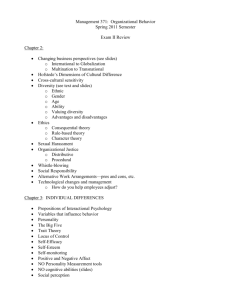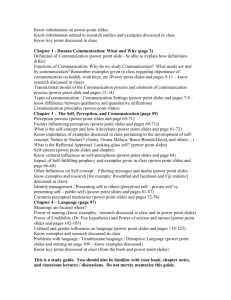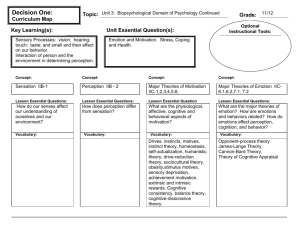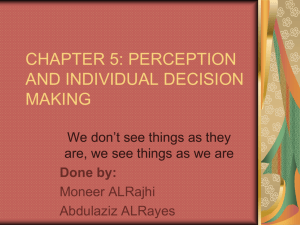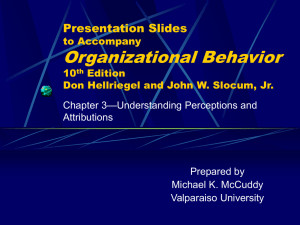Perception and Self
advertisement
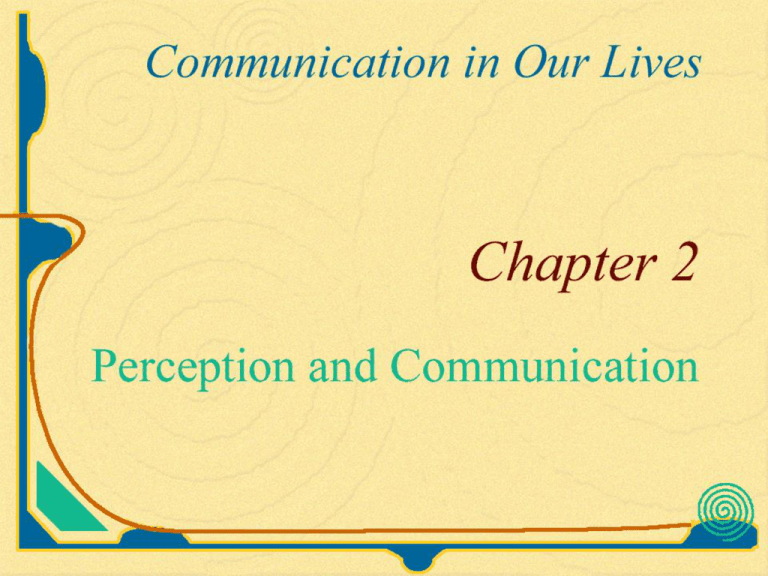
Perception Perception is an active process of creating meaning by selecting, organizing, and interpreting people, objects, events, situations, and activities. Selection Qualities in the phenomena Self-indication Culture Organization Cognitive schemata Interpretation Attributions Selection • Some qualities of external phenomena draw attention. They are larger, more intense, or more unusual. Change compels attention. Our motives and needs affect what we see and don’t see. Cultures also influence what we selectively perceive. Organization • Constructivism We organize and interpret experience by applying cognitive structures called schemata. Cognitive Schemata Prototype The exemplar of a category Best friend Romantic setting Personal Construct Bipolar dimension by which we assess people (a yardstick) Confident/not confident Moody/not moody Attractive/unattractive Stereotype Predictive generalization based on how we perceive the group into which we place people Wealthy people are conservative. Attractive women are conceited. Script Guide to action in a specific situation Engage in small talk with clerks. Avoid major disclosures on first dates. Keep friends’ confidences. Interpretation • The subjective process of explaining perceptions in ways that let us make sense of them. Attributions are explanations of why things happen and why people act as they do. Dimensions of Attributions Locus Internal External Stability Stable Unstable Responsibility Within personal control Beyond personal control Interpretation • Attributional Errors A self-serving bias • Is a bias to favor ourselves and our interests • Allows us to avoid taking responsibility for negative actions and failures by attributing them to external factors that are beyond personal control The fundamental attribution error • Involves overestimating the internal causes of others’ undesirable behaviors and underestimating the external causes Influences on Perception • Physiology—We do not all hear, see, taste the same. • Age— The older we get the more complex set of experiences we have. Time is different for different ages. Age influences our perception of social life and its problems. Influences on Perception • Culture consists of beliefs, values, understandings, practices, and ways of interpreting experience that are shared by a number of people. Standpoint Theory claims that we are affected by our culture and our location within the culture. Standpoints reflect power positions in social hierarchies. Influences on Perception • Cognitive Abilities—how we think about situations and people, and our personal knowledge of others Cognitive complexity is the number of constructs, how abstract they are, and how they interact. Person-centeredness is the ability to perceive another as a unique individual apart from social roles and group generalizations. • Person-centeredness Seeing a person not just as a member of a group but also as a unique individual • Empathy The ability to feel with another person • Some scholars argue this is difficult to achieve • Dual Perspective Understanding the perspective of another while maintaining your own Influences on Perception • Self—What we selectively perceive and how we organize and interpret phenomena are shaped by many aspects of our selves. Attachment style Implicit personality theory is unspoken and sometimes unconscious assumptions about how various qualities fit together in human personality. Guidelines for Improving Perception 1. Recognize that all perceptions are partial 2. 3. 4. 5. 6. 7. and subjective. Avoid mindreading. Check perceptions with others. Distinguish between facts and inferences. Guard against the self-serving bias. Guard against the fundamental attribution error. Monitor labels. Most Abstract Action Avoid interacting with Andrea. is selfish and Judgment Andrea immature. is taking more than Label Andrea her share of time. asks a lot of Perception Andrea questions during the meeting. Total is nervous, has Concrete Andrea academic difficulties, and Reality worries about making a good Most Concrete grade in the course. Distinguish Between Facts and Inferences • A fact is a statement based on observation or other data. • An inference involves an interpretation that goes beyond the facts. Identify whether each of the following is a fact or an inference. 1. There are 50 states in the United States. 2. HIV/AIDS is caused by immoral sexual activity. 3. Women have a maternal instinct. 4. Acid rain destroys trees. 5. Students who come to class late are disrespectful. 6. Older students aren’t career oriented. Experiencing Communication in our Lives . . . View the following video clip and then answer the questions that follow based on material presented in this chapter. A script of the scenario can be found at the end of Chapter 2. 1. Both Jim and his parents make attributions to explain his grades. Describe the dimensions of Jim’s attributions and those of his parents. 2. How can you assess the accuracy of Jim’s attributions? What questions could you ask him to help you decide whether his perceptions are well founded or biased? You may go to your student CD that accompanies the text to compare your answers to Julia Wood’s.
